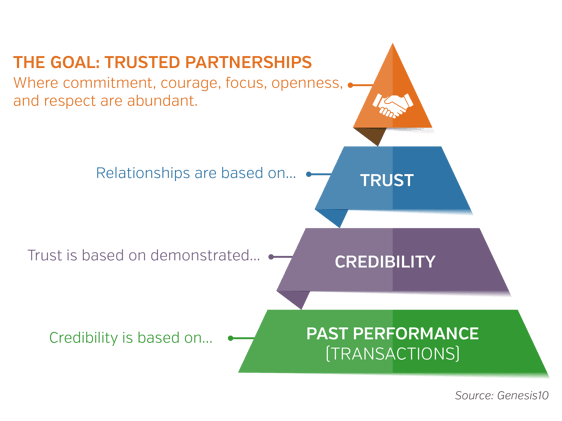We all want to be trusted. Trust takes the CEO to a new level with the board she reports to, enables the salesperson to close his big deal and is essential in doctor-patient relationships. Trust in technology is no different. We all would like to be trusted, respected as partners, and valued in our work. This is part of a joyful, fulfilling career. In software and technology development, how does trust work? Should we expect trust in new relationships? If not, how can we foster trust and respect?
Tapping the Brakes
Let’s start with an example from our everyday experience to understand how trust works. Your car brakes seem soft, and you take your car to the shop for repairs. Your service advisor looks into the problem and tells you that you need a new set of brake pads for the front brakes, and he can have your car ready in three hours and the cost will be $225. This sounds reasonable, so you agree to the repair. Unfortunately, your service advisor’s story changes over the next day, and your repair costs you $650 and two days. You feel betrayed and are reminded that the service advisor’s story always seems to change, and they can’t be trusted.
Unfortunately, this happens in technology delivery all the time. Studies consistently show that success rates in technology projects of over $1 million for delivering on time, on budget, and meeting expectations struggle to break 50%. In almost any other profession, such numbers would be unthinkable.
The Partner Pattern and Trust
Unfortunately, those of us in technology can be a bit like your car’s service advisor. Too often we say one thing, and the reality turns out to be very different. Albert Einstein stated, “Whoever is careless with the truth in small matters cannot be trusted with important matters." What we say and our past performance in our daily interactions is a foundation for trust. Let’s decompose how trust develops a bit further to understand this dynamic.
The Scrum Guide says, “when the values of commitment, courage, focus, openness and respect are embodied and lived by the Scrum Team, the Scrum pillars of transparency, inspection, and adaptation come to life and build trust for everyone.” In Leadership Patterns for Software and Technology Professionals, I describe this trust-building process in the Partner Pattern.

Here is how the Partner Pattern works:
- In any relationship, we all start at the bottom of the triangle. Let’s say you are a new Hadoop developer for Company X. Your manager asks for a status report at the end of your first week, which you complete. Repeatedly completing these transactions builds credibility between you and your manager.
- Having reached the second level of credibility, over time your manager begins to have more confidence in you. She knows that you will consistently do what you say, believes it, and mentally stops checking up on you.
- At the third level, something a bit magical happens. Other managers and executives stop referring to you as “that Hadoop developer,” and think of you as a person that they know and trust. They think of you by name, and know that they can count on you.
- Finally, you reach the level of the trusted partnership, which is where we all aspire to live and work. This is the modus operandi of any successful self-organizing Scrum team. You find yourself being consulted on a wide variety of matters, and not just technical ones. You feel like you have a seat at the table in decisions involving design, architecture, and perhaps even in planning company events.
It has taken time, but you have worked your way through the steps successfully – and you can’t imagine going back to the transactional way of working.
This pattern is at work in the way successful technology organizations interact with business partners, the interactions between Scrum teams and product owners, and perhaps most important in the way superstars build their careers. The pattern is also instructive when things are not going well. Consider:
- Technology organizations many times find themselves cycling between the levels of performance and credibility. They deliver once, twice, and then fail – sending them back to the starting line.
- Scrum teams struggle to deliver unless trust and its antecedents (commitment, courage, focus, openness and respect) are in practice. The same principle holds true of waterfall teams – but the results are too often hidden.
- In your career, if you can’t consistently deliver at the level of performance, you probably find yourself struggling to succeed. People are monitoring you to make sure you deliver on the simple transaction.
Taking Stock
Since trust is highly valued and partnership is prized, it might be a good time to take stock. In each transaction at work that your technology organization, your Scrum team, or you work on, you either build towards trust, or you detract from it. Where do you find yourself today? Are you struggling to perform and build credibility, or transitioning to a trusted partner? What might you need to change to create a different future?
As our industry transitions to new ways of working involving higher trust levels and more collaborative approaches to drive speed, old transactional ways are being left behind. Being good technically isn’t enough anymore. Trust is the new currency, and collaborative partnership the preferred way of working.
Building trust is not easy, but the steps are predictable for us all. Keeping in mind that trust can take years to earn and only a matter of minutes to lose, it's important to keep trust at the forefront of everything we do.














